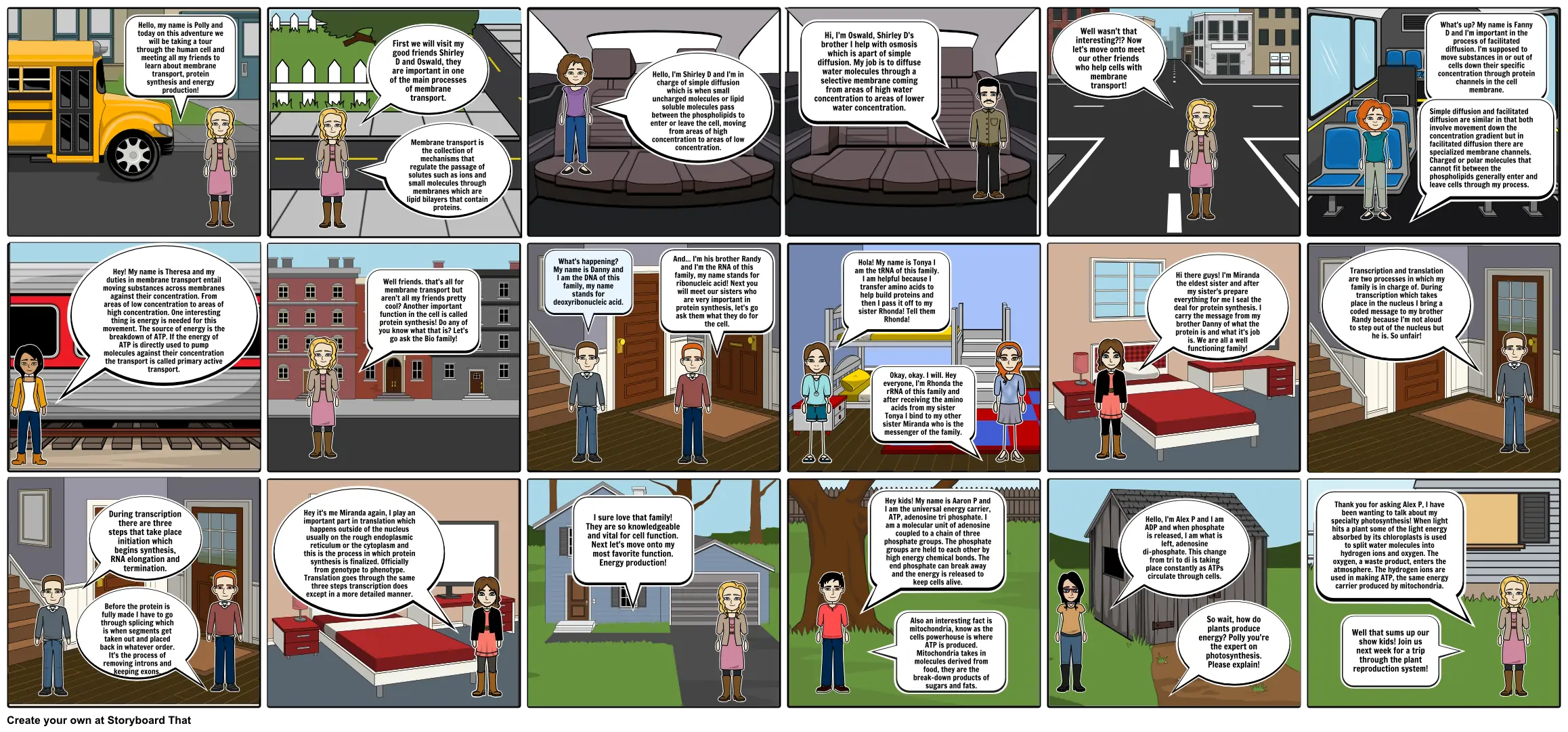Cell Storyboard

Siužetinės Linijos Tekstas
- Hello, my name is Polly and today on this adventure we will be taking a tour through the human cell and meeting all my friends to learn about membrane transport, protein synthesis and energy production!
- Membrane transport is the collection of mechanisms that regulate the passage of solutes such as ions and small molecules through membranes which are lipid bilayers that contain proteins.
- First we will visit my good friends Shirley D and Oswald, they are important in one of the main processes of membrane transport.
- Hello, I'm Shirley D and I'm in charge of simple diffusion which is when small uncharged molecules or lipid soluble molecules pass between the phospholipids to enter or leave the cell, moving from areas of high concentration to areas of low concentration.
- Hi, I'm Oswald, Shirley D's brother I help with osmosis which is apart of simple diffusion. My job is to diffuse water molecules through a selective membrane coming from areas of high water concentration to areas of lower water concentration.
- Well wasn't that interesting?!? Now let's move onto meet our other friends who help cells with membrane transport!
- Simple diffusion and facilitated diffusion are similar in that both involve movement down the concentration gradient but in facilitated diffusion there are specialized membrane channels. Charged or polar molecules that cannot fit between the phospholipids generally enter and leave cells through my process.
- What's up? My name is Fanny D and I'm important in the process of facilitated diffusion. I'm supposed to move substances in or out of cells down their specific concentration through protein channels in the cell membrane.
- Hey! My name is Theresa and my duties in membrane transport entail moving substances across membranes against their concentration. From areas of low concentration to areas of high concentration. One interesting thing is energy is needed for this movement. The source of energy is the breakdown of ATP. If the energy of ATP is directly used to pump molecules against their concentration the transport is called primary active transport.
- Well friends. that's all for membrane transport but aren't all my friends pretty cool? Another important function in the cell is called protein synthesis! Do any of you know what that is? Let's go ask the Bio family!
- What's happening? My name is Danny and I am the DNA of this family, my name stands for deoxyribonucleic acid.
- And... I'm his brother Randy and I'm the RNA of this family, my name stands for ribonucleic acid! Next you will meet our sisters who are very important in protein synthesis, let's go ask them what they do for the cell.
- Hola! My name is Tonya I am the tRNA of this family. I am helpful because I transfer amino acids to help build proteins and then I pass it off to my sister Rhonda! Tell them Rhonda!
- Okay, okay. I will. Hey everyone, I'm Rhonda the rRNA of this family and after receiving the amino acids from my sister Tonya I bind to my other sister Miranda who is the messenger of the family.
- Hi there guys! I'm Miranda the eldest sister and after my sister's prepare everything for me I seal the deal for protein synthesis. I carry the message from my brother Danny of what the protein is and what it's job is. We are all a well functioning family!
- Transcription and translation are two processes in which my family is in charge of. During transcription which takes place in the nucleus I bring a coded message to my brother Randy because I'm not aloud to step out of the nucleus but he is. So unfair!
- Before the protein is fully made I have to go through splicing which is when segments get taken out and placed back in whatever order. It's the process of removing introns and keeping exons.
- During transcription there are three steps that take place initiation which begins synthesis, RNA elongation and termination.
- Hey it's me Miranda again, I play an important part in translation which happens outside of the nucleus usually on the rough endoplasmic reticulum or the cytoplasm and this is the process in which protein synthesis is finalized. Officially from genotype to phenotype. Translation goes through the same three steps transcription does except in a more detailed manner.
- I sure love that family! They are so knowledgeable and vital for cell function. Next let's move onto my most favorite function. Energy production!
- Hey kids! My name is Aaron P and I am the universal energy carrier, ATP, adenosine tri phosphate. I am a molecular unit of adenosine coupled to a chain of three phosphate groups. The phosphate groups are held to each other by high energy chemical bonds. The end phosphate can break away and the energy is released to keep cells alive.
- Also an interesting fact is mitochondria, know as the cells powerhouse is where ATP is produced. Mitochondria takes in molecules derived from food, they are the break-down products of sugars and fats.
- Hello, I'm Alex P and I am ADP and when phosphate is released, I am what is left, adenosine di-phosphate. This change from tri to di is taking place constantly as ATPs circulate through cells.
- So wait, how do plants produce energy? Polly you're the expert on photosynthesis. Please explain!
- Thank you for asking Alex P, I have been wanting to talk about my specialty photosynthesis! When light hits a plant some of the light energy absorbed by its chloroplasts is used to split water molecules into hydrogen ions and oxygen. The oxygen, a waste product, enters the atmosphere. The hydrogen ions are used in making ATP, the same energy carrier produced by mitochondria.
- Well that sums up our show kids! Join us next week for a trip through the plant reproduction system!
Sukurta daugiau nei 30 milijonų siužetinių lentelių

